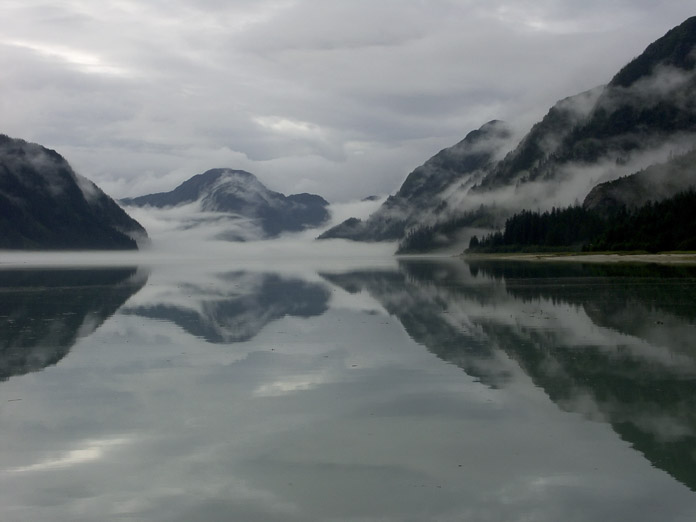
Al llegar al centro de Dundas Bay (la bahía Dundas), la niebla se hizo más espesa y noté algo extraño en la orilla, algo blanco. Conforme me acerqué más con el bote, pensé: "parece ser hielo, ¡es hielo!, ¡un iceberg en Dundas Bay!, ¿¡en verano!?" Y luego me di cuenta de que había ramas y hojas flotando, trozos de helechos y hojas puntiagudas de abeto, y empecé a sospechar lo que había sucedido. Encendí el termómetro de profundidad, y conforme me adentraba más en la bahía, la temperatura del agua bajaba progresivamente y los restos flotantes aumentaban. En el extremo de Dundas Bay, el río que drena el Brady Icefield (el campo de hielo Brady) estaba inundado. ¡Fue un jökulhlaup!, la palabra islandesa para una 'inundación explosiva'. El lago Abyss (Abyss Lake) se vaciaba, y tuve la oportunidad de ver ¡un glaciar de hielo en Dundas Bay!
As I reached central Dundas Bay the fog thickened and I noticed something odd along the shoreline, something white. As I brought the boat closer I thought, “It looks like ice! It is ice! An iceberg in Dundas Bay! In the summer!” And then I noticed the floating sticks and leaves, bits of fern leaves and fresh spruce needles, and I started to suspect what had happened. I switched on the depthfinder thermometer and as I cruised further into the bay the water temperature dropped steadily and the floating debris thickened. At the far end of Dundas Bay the river which drains from the Brady Icefield was in flood. It was a jökulhlaup! This is the Icelandic word for an 'outburst flooding event'. Abyss Lake was draining, and I got to see glacier ice in Dundas Bay! Photographer: Bill Eichenlaub